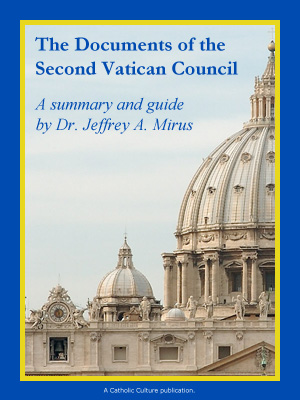Make your gift today!
Help keep Catholics around the world educated and informed.
Already donated? Log in to stop seeing these donation pop-ups.
On Melting Snowflakes and Saving Babies: The State of the Question
By Dr. Jeff Mirus ( bio - articles - email ) | Sep 05, 2013
The debate continues on the morality of embryo adoption, often called the adoption of “snowflake babies”. What is at issue here is whether it is moral to transfer a frozen embryo created through some other procedure into the uterus of a woman who is willing to carry the child to term and give birth in order to save that child’s life. Recently, for example, Joseph Mazzara argued on Catholic Stand that such an embryo transfer is immoral (see Snowflake Babies: Don’t Melt Them). This reminds me that the issue is still troubling to Catholics who try hard to think with the Church.
Free eBook:

|
| Free eBook: The Documents of Vatican II |
Mazzara is to be commended for his effort to explore a difficult question, but the particular arguments he used in this instance will not stand close examination. As some others have also done, he attempted to show that the 1987 instruction of the Congregation for the Doctrine of the Faith, Donum Vitae, teaches that embryo transfer is intrinsically immoral. But the obvious rejoinder (as we will see) is that this is not what the document says.
Pressed on this point in the ensuing discussion, Mazzara seemed to retreat into a rhetorical question: How can a woman become pregnant with another man’s child without having, in effect, committed some form of adultery? But this question (as at least one critic pointed out) assumes what it hopes to prove, for the obvious response is that a woman can become pregnant without being adulterous precisely through embryo transfer. Embryo transfer cannot be pre-defined as involving the sin of adultery because the fact of pregnancy has no bearing on the sinfulness of adultery. While pregnancy with another man’s child, in the usual course of things, is evidence of adultery, the sin of adultery does not consist in pregnancy at all, but in engaging with another in what is supposed to be a conjugal or marital act, with its implications of complete self-giving, of lifelong fidelity and commitment to one’s spouse. Pregnancy may or may not be a consequence and, if so, it may be regarded as either fortunate or unfortunate. But it has nothing to do with the intrinsic immorality of adultery.
Clearly it is necessary to go back a step, back to the text itself.
Understanding a Poor Argument
What Mazzara and many others believe is a conclusive magisterial argument against embryo transfer is drawn—through an unfortunate misunderstanding of what the text actually says—from Donum Vitae in Section II, B, 5, “Is Homologous In Vitro Fertilization Morally Licit”. In this section, “IVF” stands for “in vitro fertilization” and “ET” stands for “embryo transfer”. The two are repeatedly linked together as “IVF and ET” because, obviously, the nature of the entire procedure is first to fertilize the egg in vitro and then to transfer the resulting embryo into the body of the woman. This coupling is what has apparently caused some commentators to mistake the meaning of the text.
The section in question considers the “homologous” case (that is, the case in which the egg and sperm have been taken from the married couple involved in the embryo transfer, so that the woman carrying the baby is its biological mother, and the man to whom she is married is the biological father). Further, the text assesses the morality of the process in and of itself, that is, not based upon the question of whether other embryos have been destroyed in the process. Thus it is as close as we come magisterially to an evaluation of the intrinsic morality of the “IVF and ET” technique, abstracting from questions of parentage, abortion, and even masturbation. The most relevant passage is this:
the so-called “simple case,” i.e., a homologous IVF and ET procedure that is free of any compromise with the abortive practice of destroying embryos and with masturbation, remains a technique which is morally illicit because it deprives human procreation of the dignity which is proper and connatural to it.
So IVF and ET taken together are immoral; that much is clear. But why is this technique morally illicit? Where is the moral fault located? Every time Donum Vitae explains its conclusion it gives exactly the same reason. For example, this explanation immediately follows the judgment quoted above:
Certainly, homologous IVF and ET fertilization is not marked by all that ethical negativity found in extra-conjugal procreation; the family and marriage continue to constitute the setting for the birth and upbringing of the children. Nevertheless, in conformity with the traditional doctrine relating to the goods of marriage and the dignity of the person, the Church remains opposed from the moral point of view to homologous in vitro fertilization. Such fertilization is in itself illicit and in opposition to the dignity of procreation and of the conjugal union, even when everything is done to avoid the death of the human embryo.
In other words, the only thing that the Church has judged intrinsically immoral in the “IVF and ET” technique is the “IVF” part of it, the artificial process of fertilization. This is because, as the Church has explained in several documents, the creation of new life is intended by God to be effected through His participation in the conjugal act, which is the proper expression of the committed love characteristic of the spouses and of the family for which they will care. Creation of a new person by any other means becomes a process of technological manufacture, which inescapably tends to make the child an object, over the very existence of which the parents assume total control. Such an approach undermines the essential respect and even reverence which is always due to the human person.
The “ET” portion of “IVF and ET” is never separately considered in Donum Vitae. The question of whether “ET” is morally licit to save the life of a child who has already been illicitly conceived is neither answered nor even envisioned in this document.
Current State of the Question
In a more recent document issued by the CDF in 2008, Dignitas Personae, the question of embryo transfer is mentioned (the expression used is actually “a form of ‘prenatal adoption’”) but remains essentially unchanged. In fact, at the presentation of the document Archbishop Rino Fisichella stated that embryo adoption was still an open question. If this is true—and a strict reading of the text does support his conclusion—then what is the present state of the question?
First, let me state my own opinion (and it is just that, my opinion at present). I would argue that embryo transfer is not intrinsically immoral, and so its morality must be determined by extrinsic factors, including the intention. Think, for example, of the possibility of removing a naturally-conceived embryo from its mother’s womb in order to correct a severe medical problem which would otherwise kill the baby, and then putting it back when the successful medical intervention is completed. Approving embryo transfer in this case, of course, would not mean it would be moral in adoptive cases. But these questions remain to be resolved. In suggesting that embryo transfer is not intrinsically immoral, I am in agreement with Janet Smith, a renowned orthodox Catholic moralist who holds the Father Michael J. McGivney Chair of Life Ethics at the Sacred Heart Major Seminary in Detroit—though, as befits an open question, Dr. Smith acknowledges that some other moralists who are equally committed to orthodoxy disagree with her (see, for example, Adopting Embryos: Why Not?, which was written in March of 2009; there have been no magisterial clarifications since).
My own opinion notwithstanding, the Magisterial state of the question very clearly suggests caution, so much so that those who view embryo transfer as immoral under all circumstances have some grounds for thinking they have at least chosen the higher and safer ground. This is evident from the following three statements:
- In Donum Vitae (1987): “In consequence of the fact that they have been produced in vitro, those embryos which are not transferred into the body of the mother and are called ‘spare’ are exposed to an absurd fate, with no possibility of their being offered safe means of survival which can be licitly pursued.” Caveat: In 1987, of course, this could simply mean that no licit option had then been suggested. Again, the document gives no evidence of any awareness of the possibility of embryo transfer to save the life of the child.
- By John Paul II in an address to a 1996 Symposium on Evangelium Vitae and Law: “[I] appeal to the conscience of the world’s scientific authorities and in particular to doctors, that the production of human embryos be halted, taking into account that there seems to be no morally licit solution regarding the human destiny of the thousands and thousands of ‘frozen’ embryos which are and remain the subjects of essential rights and should therefore be protected by law as human persons”. Caveats: Here the statement is not Magisterial; moreover, even if embryo adoption were licit, it would be unlikely to resolve the problem posed by the production of huge numbers of human embryos; finally, the Pope’s use of the word “seems” is telling.
- In Dignitas Personae (2008): “It has also been proposed, solely in order to allow human beings to be born who are otherwise condemned to destruction, that there could be a form of ‘prenatal adoption’. This proposal, praiseworthy with regard to the intention of respecting and defending human life, presents however various problems not dissimilar to those mentioned above” (19). Here we have the first Magisterial comment on embryo adoption specifically. Caveat 1: The problems alluded to could relate to embryo transfer intrinsically, to the morality of surrogate motherhood, to the connection of the adoptive woman to the immoral process by which the embryo came into existence, or to the false impression that embryo transfer somehow legitimates the production of embryos. The section immediately concludes by repeating the Church’s statement of difficulty: “All things considered, it needs to be recognized that the thousands of abandoned embryos represent a situation of injustice which in fact cannot be resolved” (19). Caveat 2: But again, this would be true even if embryo adoption were ultimately determined to be licit, not least because of the sheer numbers involved.
Thus there are clear grounds for caution in Dignitas Personae, but the strict attention to what is enjoined and prohibited in properly understanding a magisterial text does not preclude the possibility that the Church will in the future resolve her moral concerns in favor of embryo adoption to save the life of the child, thereby affording at least a partial solution to an untenable situation.
This, then, is the state of the question. Embryo transfer presents problems similar enough to actions already determined to be immoral as to preclude the Church, in her latest treatment of the subject, from endorsing embryo adoption as moral. Even if she did endorse it as moral, it would certainly not be an adequate solution to (let alone provide any excuse for) the immoral production of embryos outside of the marital act. Yet neither has the Church yet concluded that embryo transfer is intrinsically immoral regardless of motive. And that is why the question remains open.
All comments are moderated. To lighten our editing burden, only current donors are allowed to Sound Off. If you are a current donor, log in to see the comment form; otherwise please support our work, and Sound Off!







